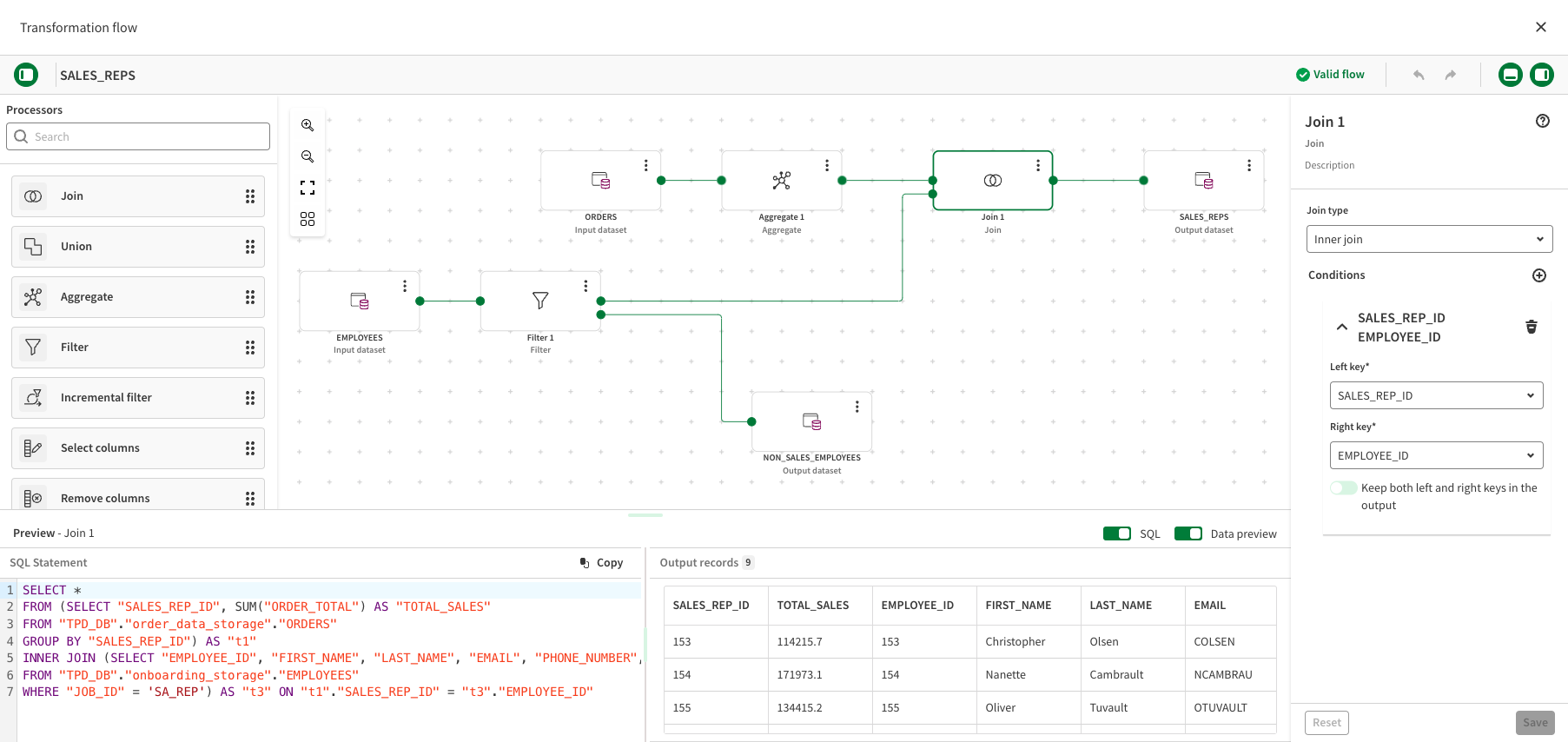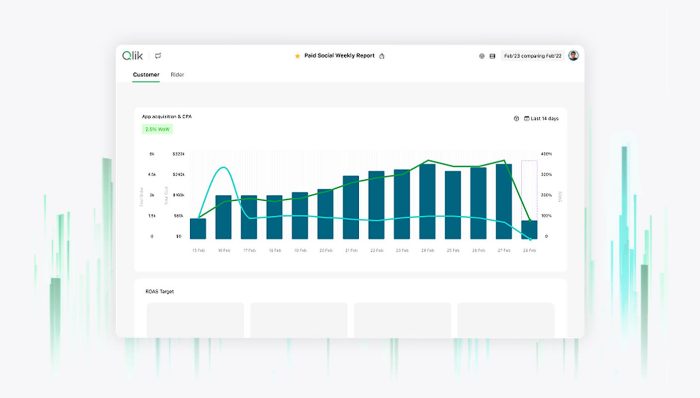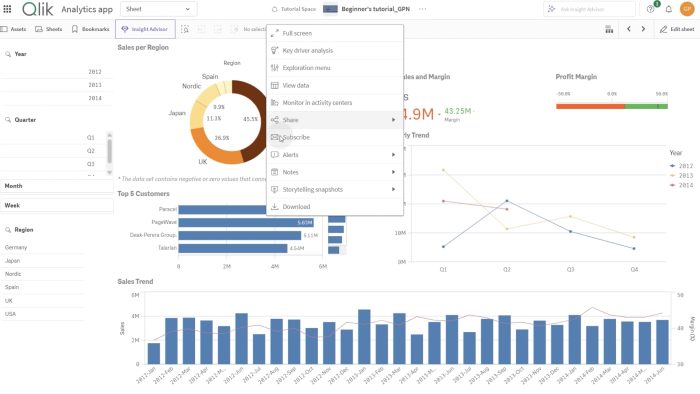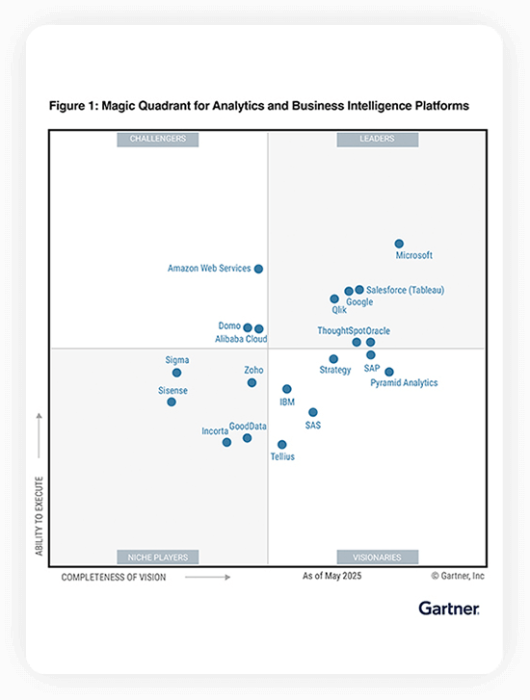Self-Service Scheduling – Task Chaining & Multi-Task Support
We’re introducing the first slice of our Self-Service Scheduling project, bringing more control and efficiency to your workflow execution in Qlik Cloud.
This is just the start—stay tuned for more powerful scheduling enhancements coming soon!
Scheduling data refreshes with tasks
Pivot table expand and collapse options
The new pivot table in the bundle has got new functions for expanding and collapsing levels. The end user can now expand and collapse the whole table directly in view mode. It’s also possible to right click on a single dimension and expand one specific dimension, a feature much wanted by our user community. Additionally, the chart now supports right-to-left reading order when activated in the app settings.
Pivot table (Visualization bundle)
Customize visualization menus
Today we’re releasing settings to configure the right click menu. As an app developer I can now decide which actions should be available in the context menu by modifying the UI settings in the app settings.
Hiding items in visualization menus
Video – Hiding items in visualization menus
Update to Data Alerts reload execution
The alert schedule configuration of When data is refreshed is now called When data changes. Alerts using this configuration will now only execute if there is a change to the data within the app.
Map chart selection styling
In our relentless pursuit to expand styling capabilities, Qlik has added the ability to change the outline color of selections in the map chart. You can now pick your own custom color instead of the default color, enhancing the styling of your geographic apps and maps.
Removal of deprecated objects
It’s time to remove deprecated charts from the bundles. The following charts have not been available in the asset panel for a long time. If you are still using them, please upgrade to new and better functionality. See the help section for pointers to replacement. The charts will be removed from the Qlik Analytics distribution in May 2026.
Map chart WMS improvements
The background layer WMS in the map chart is getting better support for Basic Authentication, a common way to protected WMS services. The WMS setup is now easier to use with dedicated fields for user credentials.
Lineage and impact analysis for machine learning content
ML Experiments and ML Deployments and their associated content are now reflected within Lineage and Impact Analysis (this will only be reflected for new activity following release).
Analyzing lineage for machine learning content
Impact analysis for machine learning content
Data Flow: Enhanced expression editor in Calculate fields processor
Data Flow now offers an improved, guided experience for writing expressions in the Calculate fields processor:
Data Flow: Expanded processors with RegEx support, multi-output forks, and number conversion
Data Flow now includes expanded no-code processor capabilities to simplify and accelerate data preparation in Qlik Cloud Analytics:
Learn in Qlik Cloud
Experience a smarter way to learn. Qlik’s new Learn page (replacing Getting started) offers step-by-step, outcome-based learning paths to help you succeed.
From onboarding to advancing your skills, every step is designed for real results. Track your achievements, dive into fresh content, and gain the most from Qlik—all in one place.
Accessing the Administration activity center
Glossary export and import for Excel and CSV files
Business glossaries are most often managed in shared spreadsheets with terms and definitions. With this release you can now import these glossaries into Qlik Cloud using that xlsx or csv file. Additionally, exporting your glossary in these formats is an option, adding to the existing import/export formats of Qlik, Atlas, and Atlan which are JSON based.
For more information, see Importing and exporting glossaries.
PixelPerfect report authoring – refresh source data binding for new measures/dimensions
PixelPerfect report developers can now easily refresh a data binding definition when the source Qlik Sense chart/table definition has been modified.
Org Chart, now with images and new styling settings
The Org chart in the bundle is getting new styling settings including an option to include an image by URL in the card, perfect to make your hierarchy charts look even more awesome.
Talend Studio Jobs runtime lineage in Qlik CloudCatalog
With the latest update to Qlik Cloud, users can now seamlessly connect Qlik Talend Cloud Studio Jobs to Qlik Cloud Catalog. Data consumers get full runtime lineage across Talend Studio projects and cross applications.
This will enable governance across Talend Studio and Qlik Cloud datasets.
Key features with this update
Qlik Cloud unlocks a unified experience with:
This seamless integration bridges data integration design and governance, making it faster and easier to deliver trusted, high-quality data to consumers.
Publishing datasets and lineage to Qlik Cloud
Understanding your data with catalog tools
Recommended machine learning models
New enhancements are available to provide recommended models as you train models in an ML experiment. The ML experiment recommends up to three models based on the current filters you have applied in the Models tab.
Selecting the best model for you
Improved download access in visualizations
Downloading visualizations is even faster now – Download is now an option in the hover menu in visualizations. Get your images, data, and PDFs with fewer clicks!
Name updates for Qlik Cloud features
We’re updating the names of two components in our Cloud offering to better reflect their functionality:
These changes are being rolled out as part of a phased update across the platform. You may start to see these new names in the interface over the coming weeks. During the transition, both old and new names may be visible depending on your region.
Line chart shapes with labels and symbols
Enhancements have been made to shape creation (formerly known as plugins) for line charts. In addition to the points and lines, it’s now possible to add labels and symbols with options for size, color, and placement. Shapes are a great way to increase data literacy by proving valuable context for interpretation of the chart.
Glossary export and import for Excel and CSV files
Business glossaries are most often managed in shared spreadsheets with terms and definitions. With this release you can now import these glossaries into Qlik Cloud using that xlsx or csv file. Additionally, exporting your glossary in these formats is an option, adding to the existing import/export formats of Qlik, Atlas, and Atlan which are JSON based.
For more information, see Importing and exporting glossaries.
Create pull requests in Qlik Talend Cloud pipelines
With this new release, we’re introducing an improvement to our version control integration with GitHub.
After committing and pushing their changes, users can now create pull requests directly within their pipeline project.
Previously, pull requests had to be initiated from GitHub. With this update, users can generate pull requests within Qlik Talend Cloud and open them in GitHub for review and merge—streamlining the workflow and saving time.
Manage your projects with version control
Create custom semantic types for enhanced data classification and validation
With the latest update, users can now create custom semantic types, ensuring more accurate data classification and validity compute. This feature provides flexibility through dictionary, pattern using a regular expression, and compound type configurations.
AI recommended relationships in Qlik Talend Clouddata models
You can now use AI to recommend relationships when creating the data model in Qlik Talend Cloud pipeline tasks.
The AI recommended relationships capability uses metadata to detect possible missing relationships in your data model:
For more information, see Creating a data model.
For more information about availability and information that is shared, see Generative AI-based assistant in Data Integration.
Quality compute pushdown now available for Databricks Unity
The latest Qlik Cloud update introduces pushdown data quality compute for datasets on Databricks Unity. This enhancement allows users to leverage Databricks’ processing power, optimizing resource usage while maintaining flexibility in data quality checks.
Key features
Data quality for connection-based datasets
Data quality validation rules
With the validation rules for Qlik Cloud, you can now create reusable business requirements that automatically detect data anomalies. Define what your data must comply with through customizable validation rules that can be applied across your datasets, ensuring consistent quality standards.
Support for Snowflake secure views
Qlik Talend Cloud Pipelines now supports Snowflake secure views for better data privacy control. You can now configure storage, transform and data mart tasks to generate secure views in order to obfuscate view’s structural details from data consumers.
Snowpipe Streaming support
Previously, Bulk loading was the only method available for loading data into Snowflake. Now, customers can use either Bulk loading or Snowpipe Streaming to onboard or replicate their data to Snowflake.
The benefits of Snowpipe Streaming over Bulk loading include:
Data marketplace, Catalog, and Data quality now supported in Qlik Cloud Government
Qlik Cloud Government users can now maintain trusted, consistent data across diverse sources and formats, enhancing reliability for various business needs across the platform.
With this update, Qlik Cloud Government strengthens its integrated data management offering with the following capabilities available in Qlik Talend Data Integration:
Data marketplace,
Where data products are readily available for data consumers to shop and leverage according to their use cases. Within the data marketplace, data consumers can get a sample preview of the data products, including quality information, descriptions, and relevant tags.
Data product quality and profiling
Where data product teams can get a quick data sample, profile the data based on the different data types, and ensure the integrity of the data within the data product. In the case of Snowflake tables, data quality assessments are pushed down into Snowflake to optimize compute operations.
Data product lineage and impact analysis
Allows users to trace the origins and transformations of data products. Understanding where the data came from and how it changed along the data pipeline enhances data trust and brings more transparency for data consumers.
Integrated data catalog experience
Data products can be composed of datasets that are registered in theQlik Talend Cloudcatalog, streamlining the workflow for data product teams without requiring any additional tools.
Data product access control through managed spaces
Simplifies access control for data products, emphasizing easy data sharing with data consumers within the Qlik Talend Cloud environment.
Data product life cycle management
Enables data product teams to treat data products just like real products, composing them from relevant datasets, evaluating data quality, assigning ownership, managing data product attributes (such as description, tags, and more), and launching them for consumption. If a data product no longer meets business needs, it can be deactivated.
Data product consumption using Qlik Cloud Analytics apps
Allows data consumers to easily load data products into Qlik Cloud Analytics apps, enabling a seamless transition from data discovery to actionable insights with just a few clicks.
Browsing datasets from the Catalog
AI processor for transformation flows now supported in Qlik Cloud Government
A new processor has been introduced in transformation flows to make it easy to leverage your Databricks platform’s AI capabilities. The AI processor includes seven state-of-the-art generative AI functions:
The AI processor also supports Snowflake Cortex AI functions. The Snowflake implementation of the AI processor includes four state-of-the-art generative AI functions:
Transformation flows for SQL and Microsoft SQL Server now supported in Qlik Cloud Government
SQL Expression processor is now available as part of Transformation flows in Qlik Cloud Data Integration for Qlik Cloud Government. The SQL Expression processor lets you write simple or complex SQL expressions to process data in a new column of your source dataset.
Transformation flows are now supported in data pipeline projects using Microsoft SQL Server as target. Users can now develop graphical transformations alongside the custom SQL based transformations to support complex requirements for reshaping data.
Graphical transformation flow designer now supported in Qlik Cloud Government
Qlik Cloud Government users can now access the Qlik Talend Data Integration no-code transformation designer. The simple drag-and-drop interface makes creating visual transformation flows easy for both data engineers and non-SQL experts alike. You can use transformation flows as an alternative to custom SQL code as part of your ELT data pipelines.

The transformation flow designer offers a palette of various data transformation processors to cleanse and shape your datasets. Transformation processors offer various data manipulation operations such as string and number functions, cleansing, and hashing, and re-structuring capabilities such as joining, aggregating, and filtering data.
Qlik Talend Data Integration converts transformation flows to SQL statements, orchestrates them, and pushes them to your data platform of choice for runtime execution. Snowflake, Databricks, Google BigQuery, Azure Synapse Analytics and Microsoft Fabric are supported data platforms.
Finally, transformation flows support all automated SQL-based transformation capabilities, including materialization, incremental processing, and type 2 history tracking.
……. … ………… ….
Any questions please contact our consultants. Responding in one working day.


